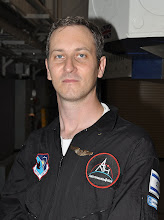 One week in March I got to live a bit of my space aspiration. No, I didn't go to space (I continued to ride spaceship Earth). What I did was to go through two segments of commercial astronaut training. After AGSOL near Boston it was time for NASTAR near Philadelphia. Over three days I went up to a simulated 25,000ft altitude in a hypobaric chamber and went on simulated flights that exposed me to real 3.5Gz, 6Gx and most exciting of all, a virtual ride on SpaceShipTwo.
One week in March I got to live a bit of my space aspiration. No, I didn't go to space (I continued to ride spaceship Earth). What I did was to go through two segments of commercial astronaut training. After AGSOL near Boston it was time for NASTAR near Philadelphia. Over three days I went up to a simulated 25,000ft altitude in a hypobaric chamber and went on simulated flights that exposed me to real 3.5Gz, 6Gx and most exciting of all, a virtual ride on SpaceShipTwo.NASTAR is a place that trains many types of people, from fighter jet pilots to aspiring astronauts and space tourists. Over the past five years, after being spun-off of a manufacturing facility for centrifuges, altitude chambers and simulators, it formed several training programs around suborbital flight. The one I went through with seven other men and women was Suborbital Scientist Training, meant for people who will not only go to space as tourists, but will actually need to function in the few minutes of weightlessness rather than just admire the view. My plan B is to win the lottery...
Gear
In contrast to AGSOL's no-fanfare frugal academic lab-in-a-basement, NASTAR's simulation equipment is matched with presentation. The classroom and binders are tasteful and provide a good learning experience, and the flight suit everyone got, bearing the NASTAR patch and the US flag (which I replaced with the Israeli one) had a cool geeky factor that added a level of reality to everything we did. I also proudly wore the Astronauts4Hire patch.
Lastly, I had my Garmin watch to measure my heart rate during the centrifuge flights and I brought something I borrowed from my kids to use during the final one, but more on that later...
Day 1 - High Altitude
 |
| In the altitude chamber (credit: NASTAR) |
 |
| Waiting to get virtually high |
The Centrifuge
 |
| The NASTAR centrifuge with people for scale. You sit in the capsule on the right. |
Day 2 - Hello, Gs
The second day at NASTAR was a preparation day to the final day, a day to learn techniques to handle sustained G forces one doesn't experience on Earth (not even on roller coasters) so that we don't miss any of the fun by losing consciousness (G-LOC) when we fly a full suborbital flight profile. The purpose of the 2 "flights" on day 2 was to train us with techniques to counteract +Gz (downward) and +Gx (front to back) forces and identify signs that would lead to loss of consciousness. As someone who usually lives in about 1G the sensations were great and I'm happy to report the countermeasures work fine. For the +3.7Gz profile, knowing that after partial loss of vision usually comes G-LOC and "the chicken dance" gives you the necessary motivation to do what you're told to avoid it. The +6Gx profile does not make you faint, however it makes you heavy. For 20 seconds I weighed over 1,000 lbs (almost half a metric ton!), but then I shed the extra 900 lbs at the same speed I gained them. Fastest diet ever. Doing air push-ups (moving the arms like during push-ups) feels like holding some pretty heavy dumb-bells.
Day 3 - One Giant Leap...
On day 3 we went through an exercise in performing an experiment while simulated passengers make us want to throw them out the air-lock (lucky for them there is none in currently built suborbital spacecraft), an important simulation that may take place in reality in a few years, when paying customers may ride with people performing micro-gravity experiments.
The most anticipated on that day was the simulated SpaceShipTwo flight profile. It is the closest thing possible to the real thing and combines audio, video and of course G forces. At the "zero gravity" part, when the "rocket engine" turned off, I pulled out what I borrowed from my kids - a Lego astronaut. While holding it in my hands I said something I prepared the night before. Corny, maybe, but it embodied my feelings and sense of accomplishment. Yes, I paraphrased some other guy 43 years ago, and yes, I actually didn't leave Earth gravity or even sea-level, but the sensation was real. The G forces were real. The feeling was real.
Epilogue
 Nicely tying the two very different experiences that spring week in March on the east coast was a picture of Ashton Graybiel that hangs at NASTAR, alongside others under the heading "Giants of the SD World" (SD = Situational Disorientation). It was interesting to see past tied with future. Sure, we didn't land on Mars in the 1980s like Von Braun pushed for, but space, in its own peculiar way, is getting closer.
Nicely tying the two very different experiences that spring week in March on the east coast was a picture of Ashton Graybiel that hangs at NASTAR, alongside others under the heading "Giants of the SD World" (SD = Situational Disorientation). It was interesting to see past tied with future. Sure, we didn't land on Mars in the 1980s like Von Braun pushed for, but space, in its own peculiar way, is getting closer. |
| After graduation. Note the NASTAR wings and Israeli flag |

 Space Shuttle Launch Poll Results
Space Shuttle Launch Poll Results













No comments:
Post a Comment